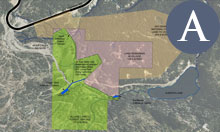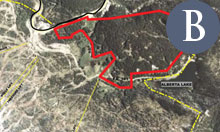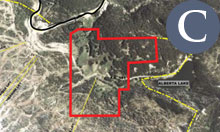The Land Exchange
How the Village Land Exchange originated.
When hired to work on The Village at Wolf Creek, our new development team began looking at alternatives to the original plan for the Village in response to input received from the surrounding communities, the United States Forest Service (USFS), and the Wolf Creek Ski Area (Ski Area). Much of that input expressed a desire for two things: preserve the ski experience at the Ski Area and protect the high quality wetlands located near the base of the Alberta Lift. Those desires combined with other comments we received made it clear that the best place to build the Village would be on land in a heavily forested area near Highway 160 that is further from the ski slopes and away from the wetlands. Such a move would also support the USFS's forest management by eliminating a private "in holding" surrounded by National Forest lands which by Federal statute is guaranteed access. That is how we came to consider an exchange of land with the Forest Service. The Village at Wolf Creek Land Exchange would trade a portion of our privately owned land in Alberta Park and part way up the ski mountain for National Forest lands located closer to the highway. (See Map A)
Here is what we have proposed.
To complete a land exchange, the USFS must comply with a number of Federal statutes, including the National Environmental Policy Act (NEPA). In June, 2010, we submitted an exchange proposal to the USFS as the first step in the land exchange process. In our proposal, we also included a request that the USFS grant road access to our private land should the exchange be denied. So, our proposal calls for the USFS to either:
(a) exchange part of the land that the Village currently owns near the Ski Area for land closer to Highway 160 (see Map B); or
(b) grant road access to our private "in holding" under the Federal statute known as the Alaska National Interest Land Conservation Act (ANILCA) (See Map C).
Under the proposed Land Exchange, the Village would trade 178 acres of private land to the United States in exchange for 204 acres of Rio Grande Forest lands. These land exchange parcels are shown on the Land Exchange map depicted in Map A. To complete a land exchange our proposal is structured as an either/or choice because while the USFS has discretion to deny or grant the land exchange, the USFS is obligated to grant us access to our property. As recently explained in one of the local papers, the USFS representative said, "should the agency decide against the land trade, it still would have to allow for access to the property."
So, what does this mean?
The decision on the exchange boils down to whether it is preferable from the public's perspective for us to build on the land we presently own or whether it is better for us to build on the land further away from the Ski Area and wetlands. The Forest Service's Environmental Impact Statement ("EIS"), prepared to comply with NEPA, provides for the decision maker (in this case the Rio Grande National Forest Supervisor) the environmental, social and economic impacts associated with the proposed land exchange and reasonable alternatives to the exchange, which includes the Forest Service granting access to our current property.
Despite the fact that the USFS is obligated to grant access to the property we currently own, we have proposed the Land Exchange because it is in our opinion the better of the two options. Most people when faced with these two options have come to the same conclusion. Sure, there are those that would like you to believe that, if you object to the Land Exchange, the alternative access will not happen. But, that is simply not the case. The USFS has made it clear in their press releases and in the Notice of Intent to Prepare an Environmental Impact Statement published in the Federal Register on April 19, 2011 (Click here for the Notice of Intent) that should the Land Exchange not be approved, the USFS will grant us access to our current property:
As the owner of a private inholding, the Non-Federal Party has a legal right for access commensurate with its intended use. As per ANILCA, the United States has a statutory obligation to provide the Non-Federal Party with "… access to non-federally owned land within the boundaries of the National Forest System… to secure to the owner the reasonable use and enjoyment thereof…"
Proposed Action: Given the Non-Federal Party's legal right to access its property and the Rio Grande NF's legal obligation to provide access to the inholding, the Rio Grande NF believes that a land exchange may be in the public's interest and thus merits additional evaluation.
Why is the proposed Land Exchange better?
We believe the Village at Wolf Creek Land Exchange offers an opportunity to develop a village that is unique in character compared with other ski villages. Specifically, by moving the Village into the trees away from the ski mountain, it creates a place of tranquility and solitude not found at other ski areas. Not to mention that it minimizes any disruption to the experience one feels when skiing at Wolf Creek.
Here are the potential public benefits as outlined by the Forest Service in their Draft EIS:
- development of private lands would be moved further east from Wolf Creek Ski Area, and would minimize impacts to skiers and ski area operations.
- the land exchange would focus residential development and associated infrastructure in an area that is more suitable due to topography, natural resources, and proximity to US Highway 160.
- the proposed land exchange would lead to a net gain of wetlands and perennial streams in public ownership.
- the proposed exchange would accommodate a lower density development.
- the land exchange would replace the need for ANILCA access.
What role does the public play in the NEPA process?
The public comment period to express their opinions as to whether they prefer the USFS to approve the proposed land exchange or grant us access under ANILCA.
Once the public comment period is over, the USFS will analyze the comments received and commence work on the Final EIS and its Record of Decision which will represent its final decision on the Land Exchange versus giving us access.
If the Land Exchange is approved, the USFS will prepare the necessary closing documents and complete the exchange. If access is chosen, the USFS will prepare an access easement granting us access to our current property.

Click images to enlarge




